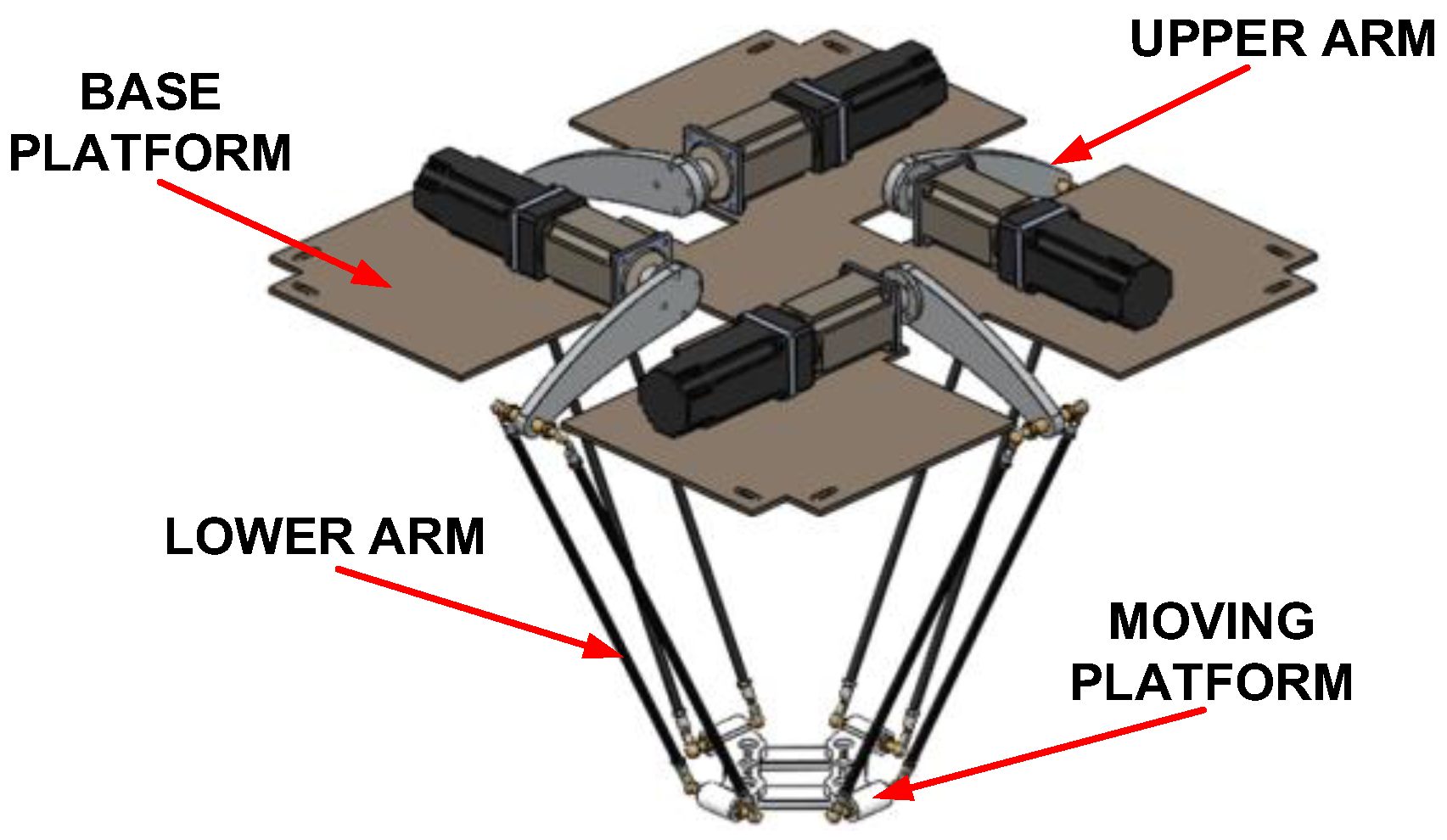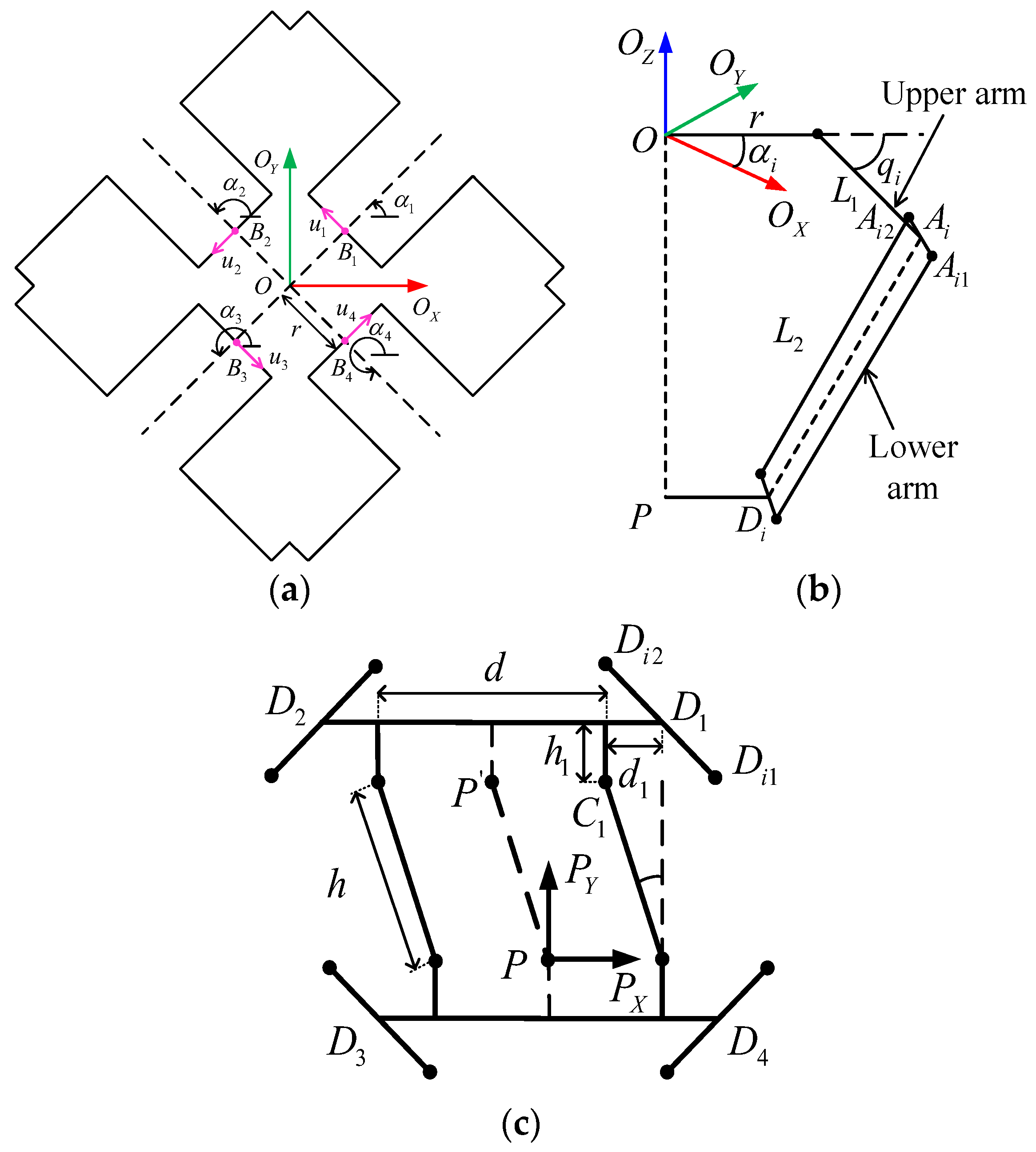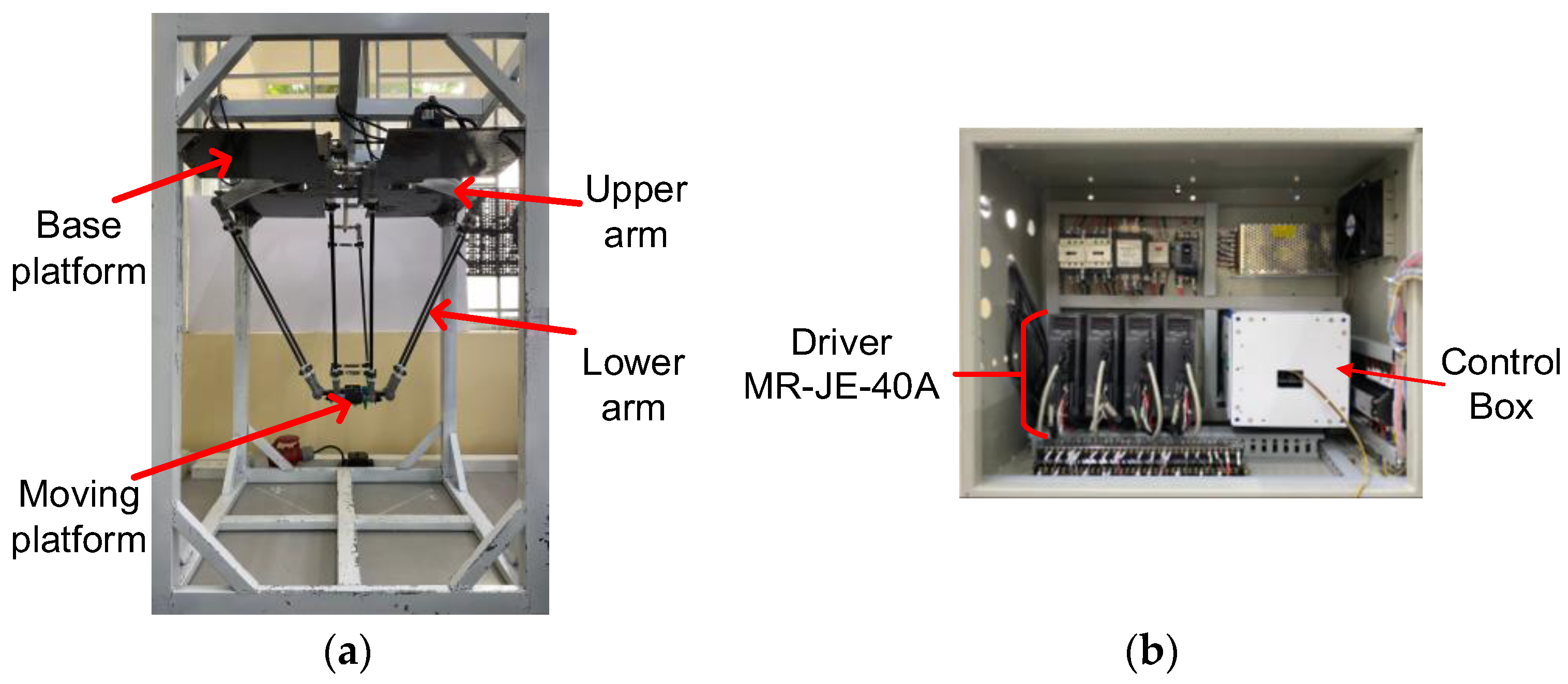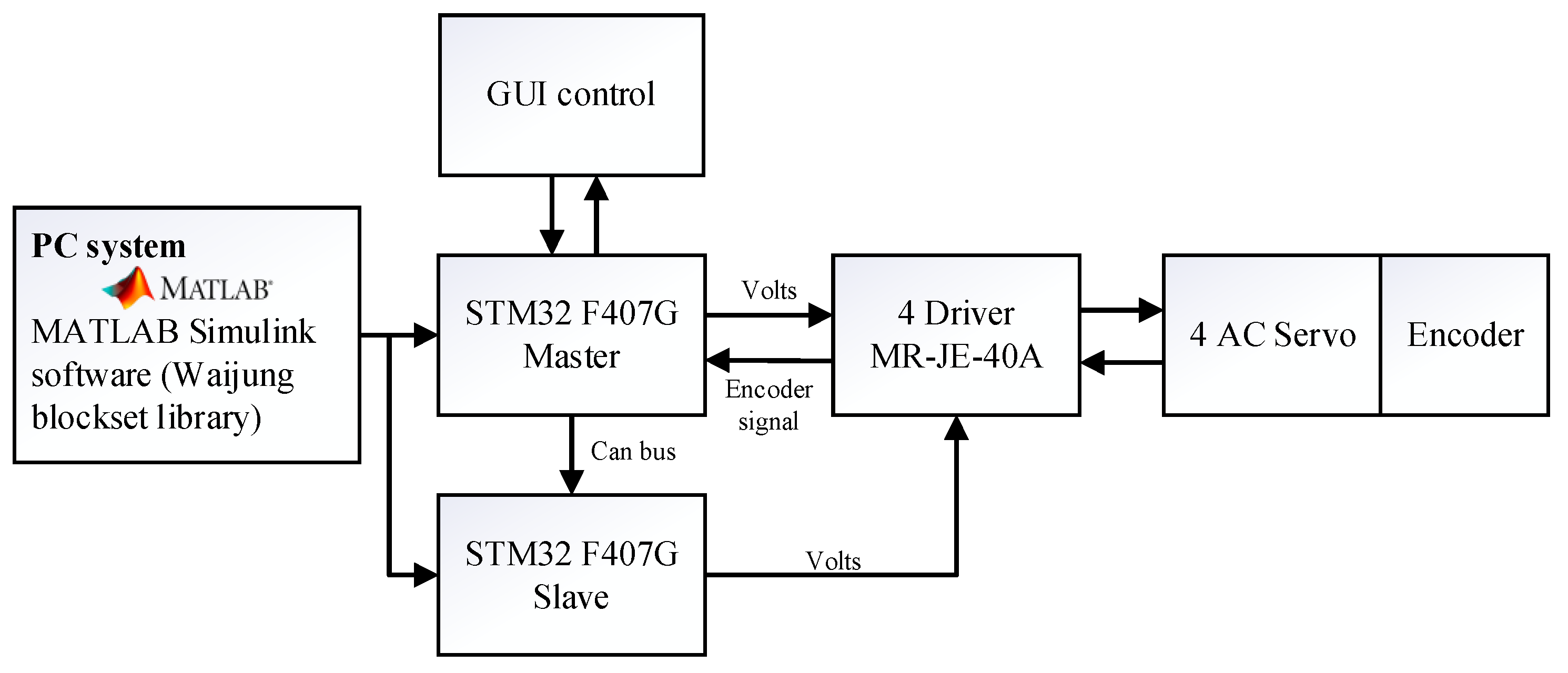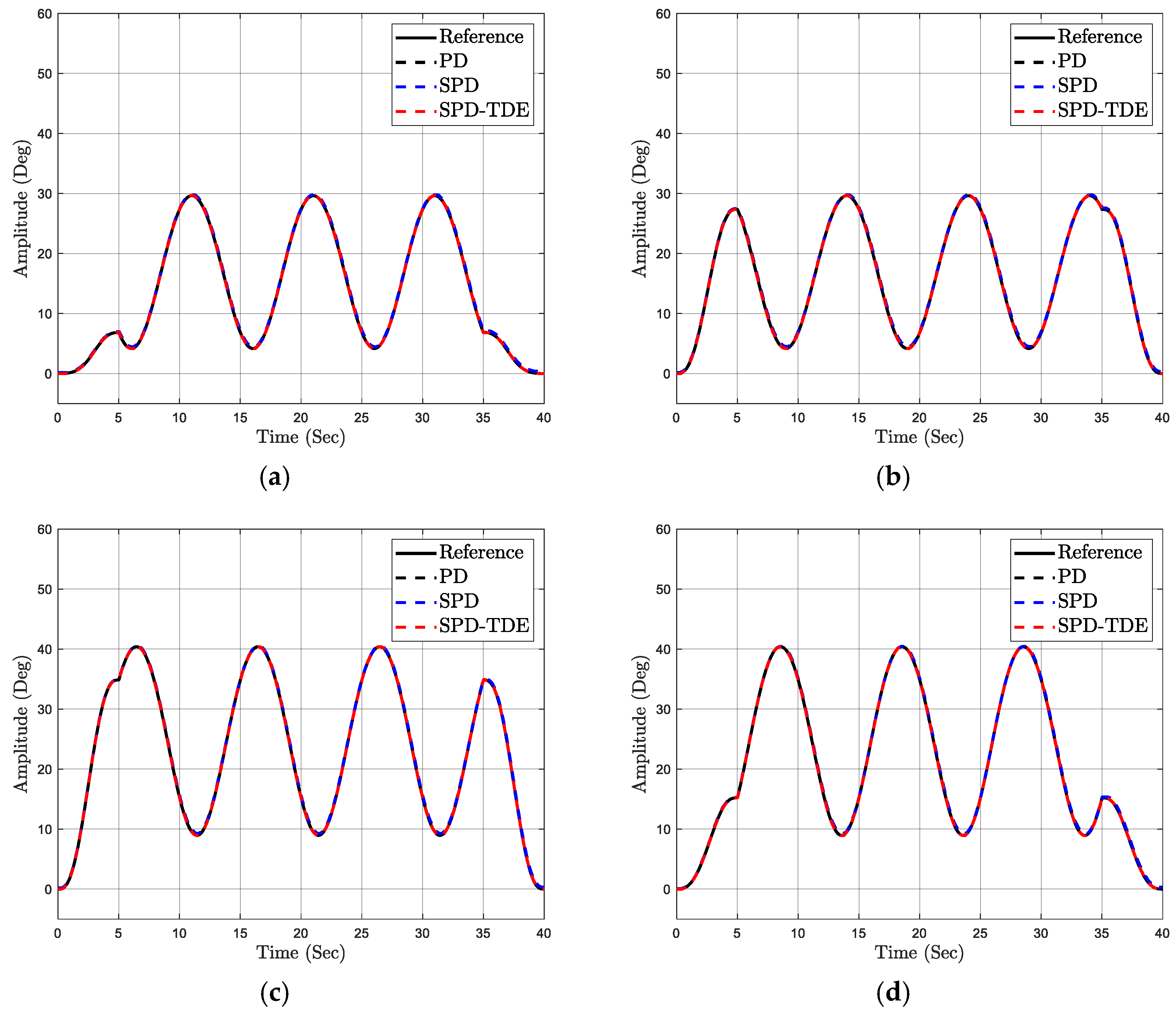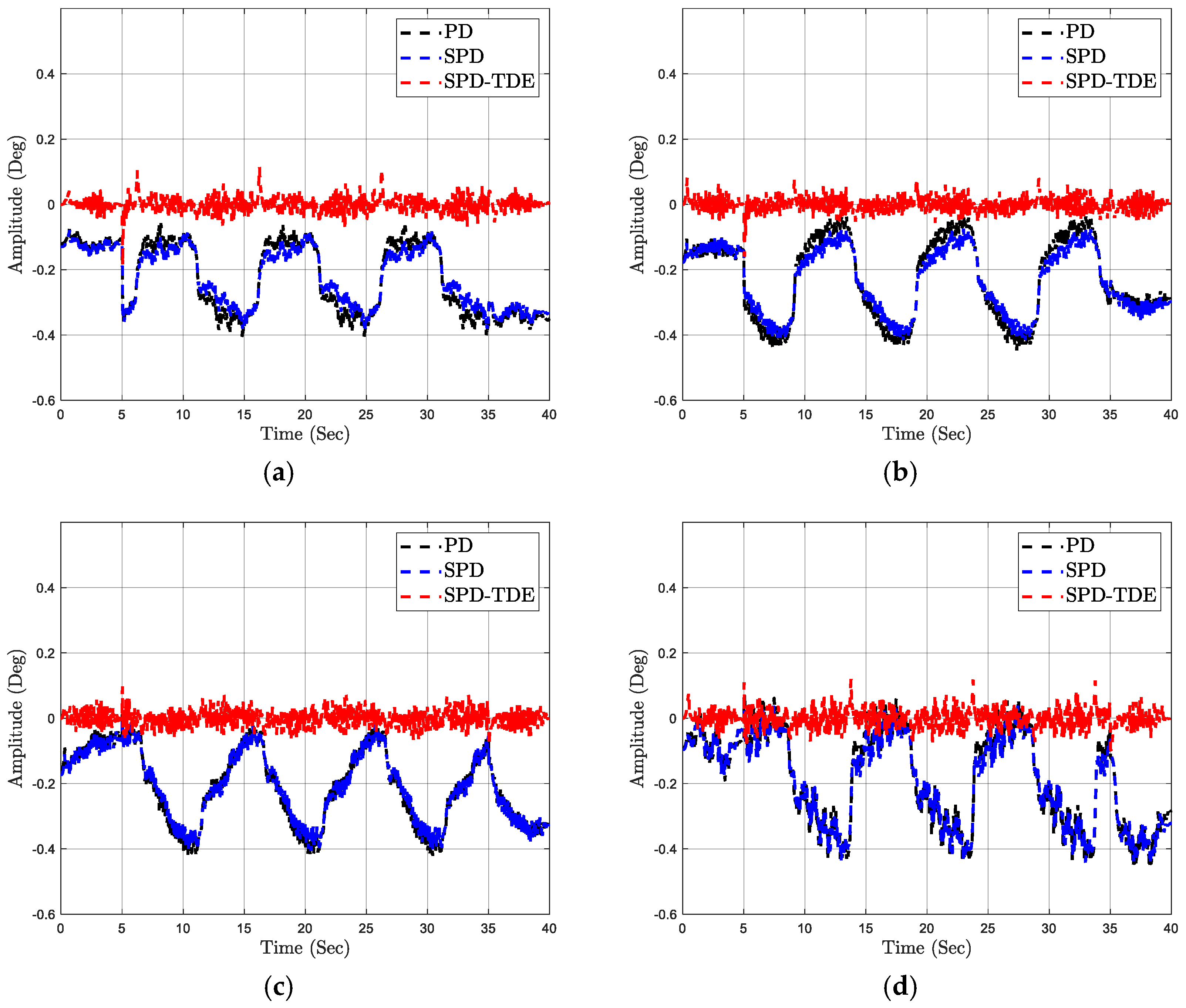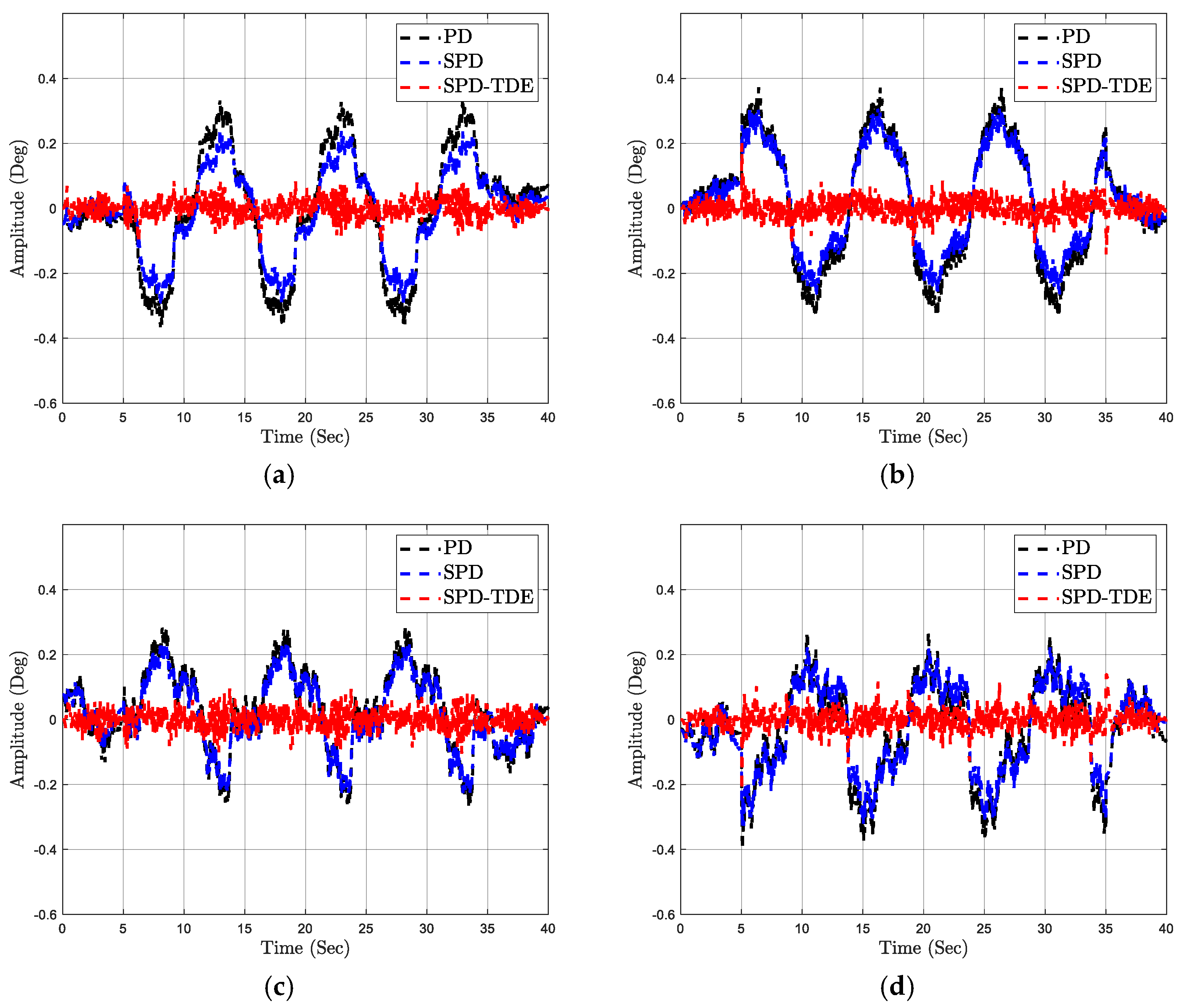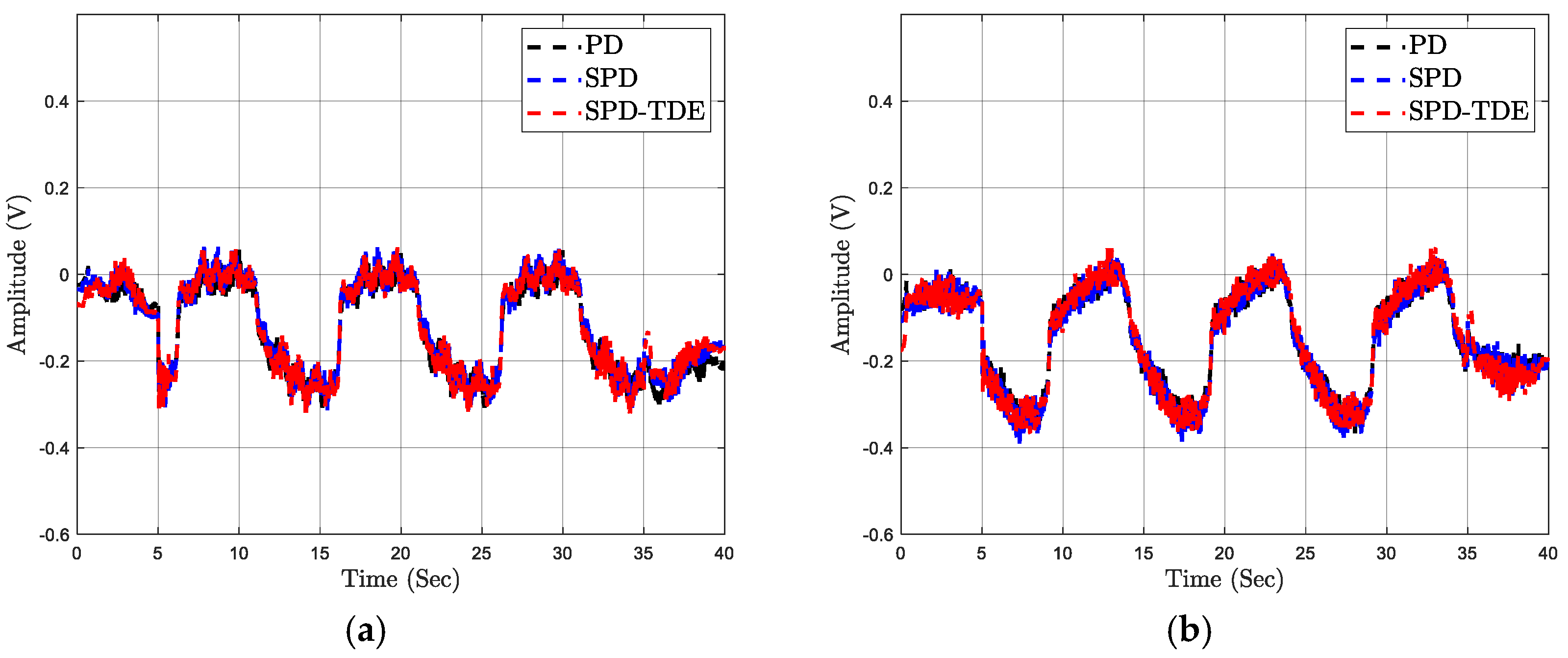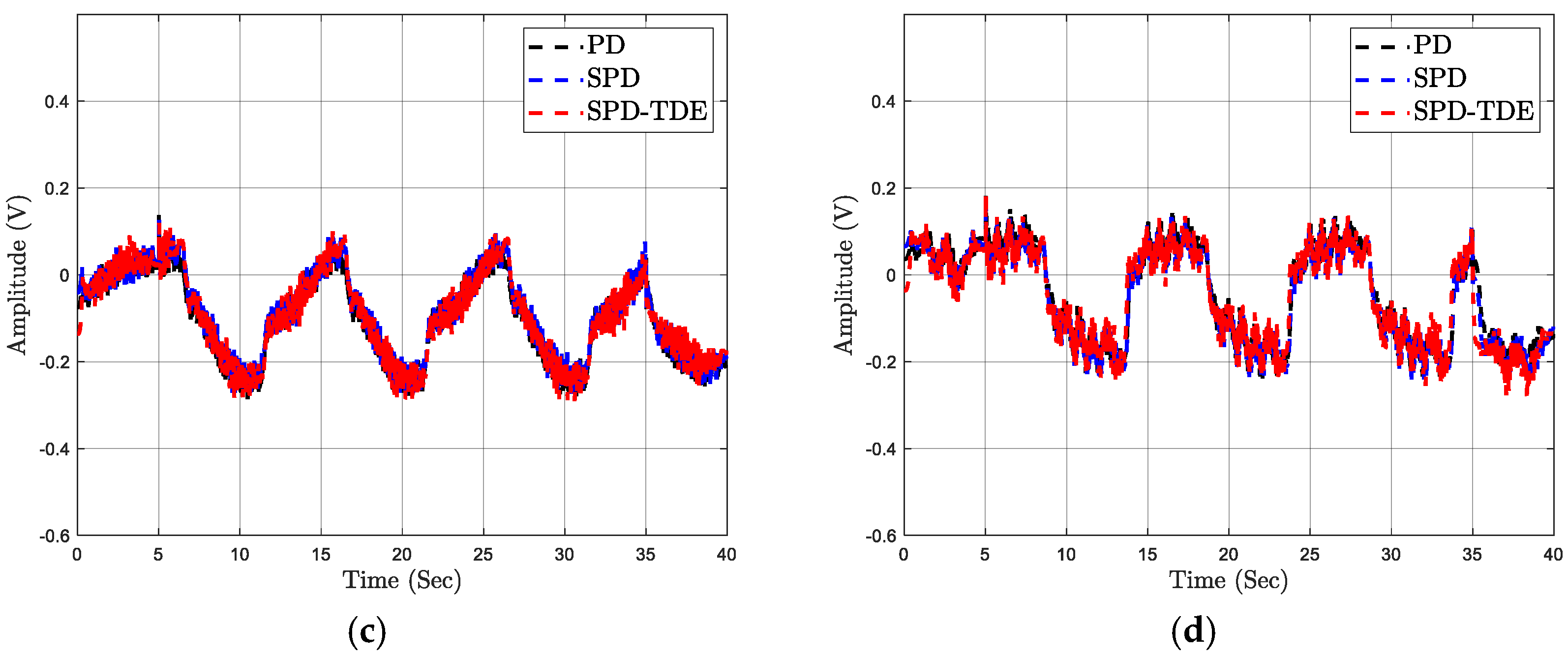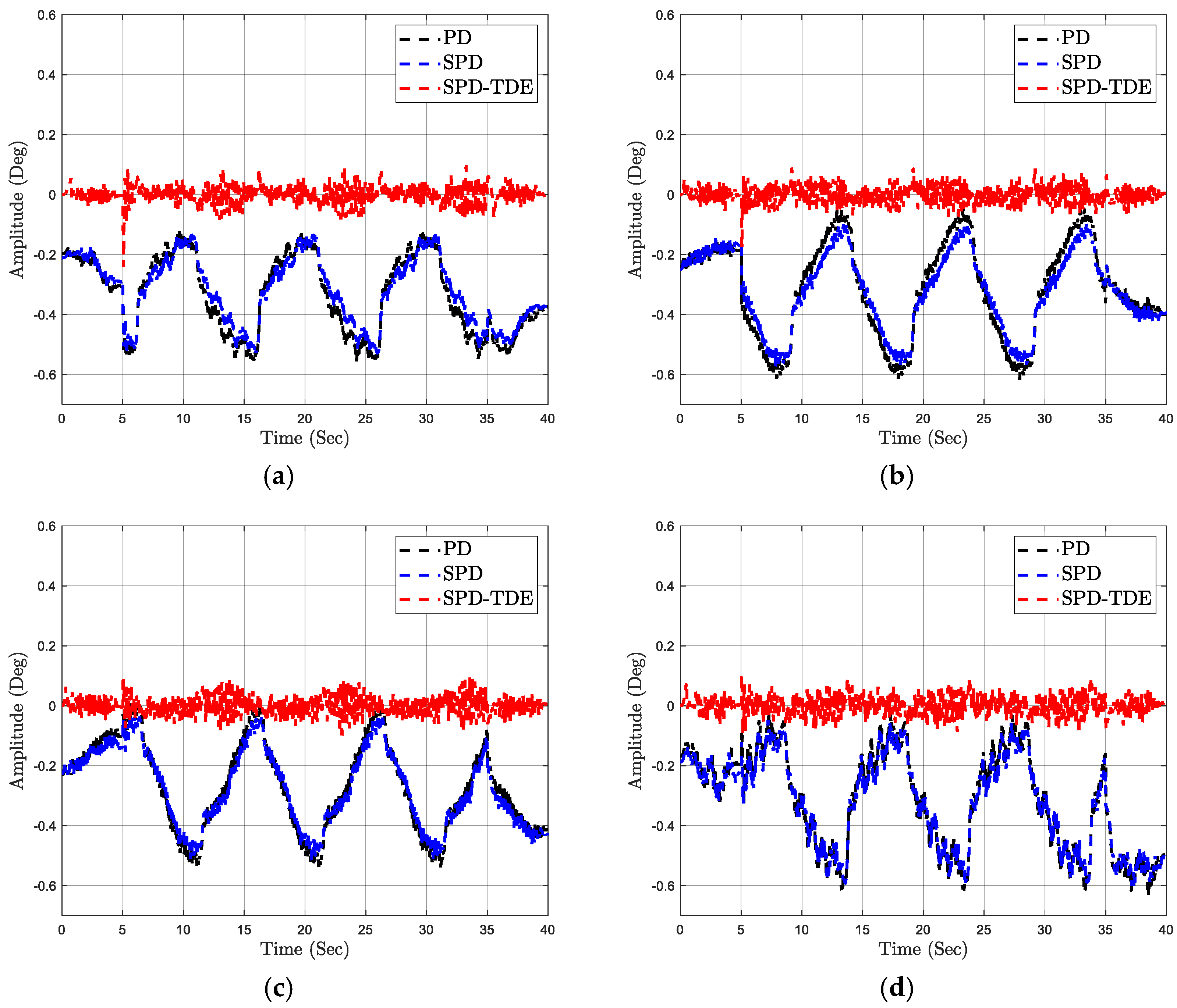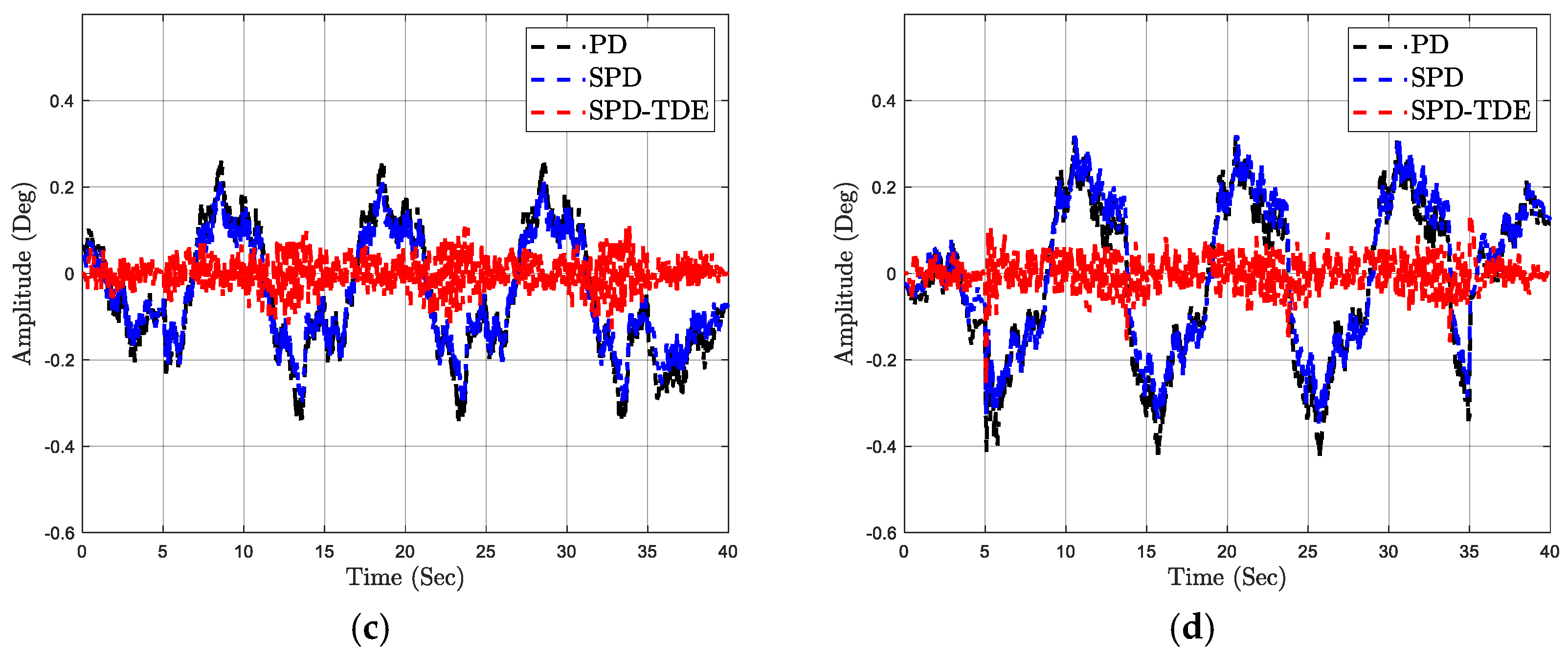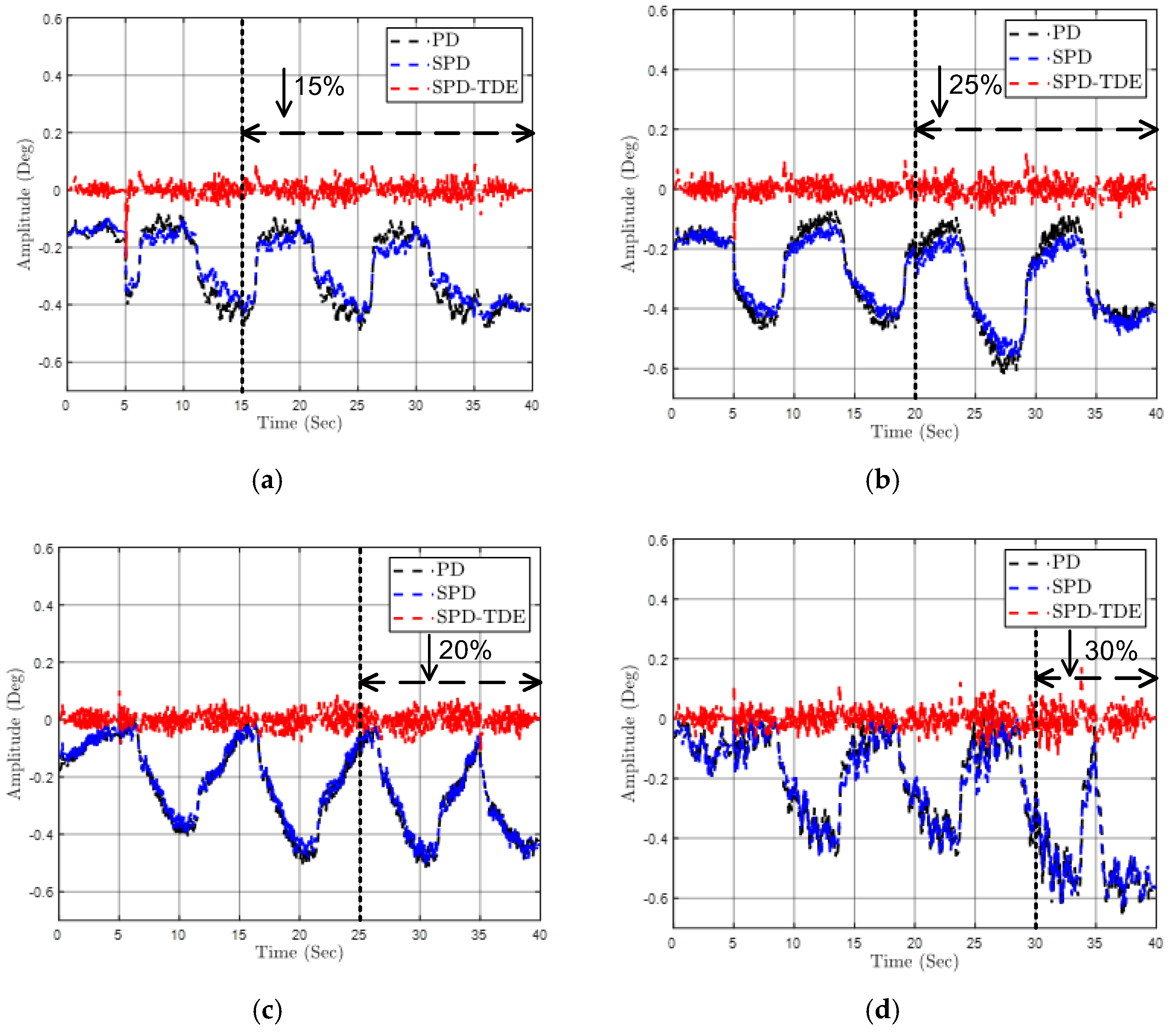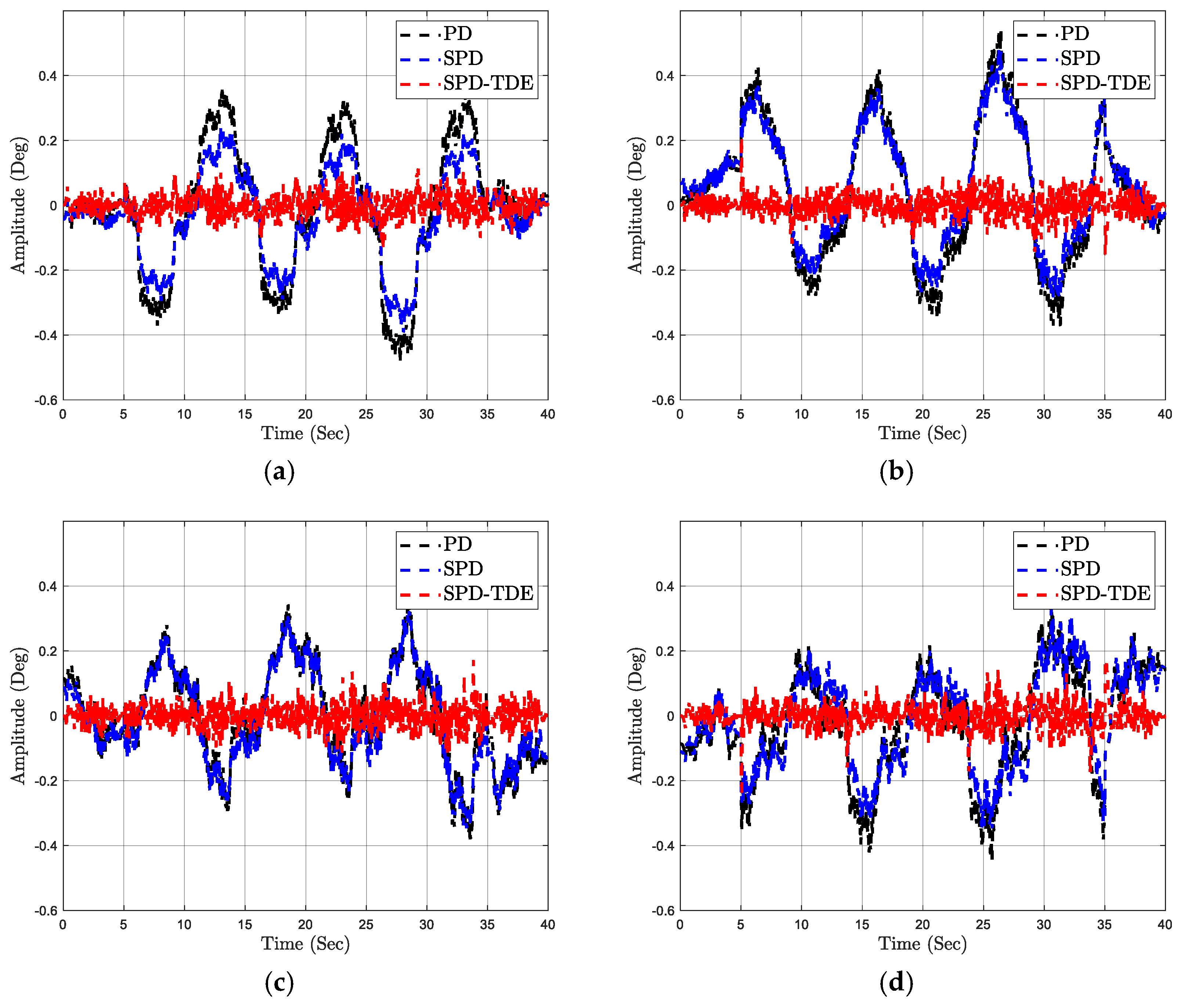1. Introduction
Nowadays, robots are applied in many fields to replace humans in performing different tasks and to improve production productivity as well as product quality. There are many types of robots that have been researched, developed, and commercialized, and one of them is the parallel robot. The parallel robot has a closed-loop structure; the fixed base is linked to a moving platform with parallel and identical kinematic chains. It has been widely applied in many fields, such as industry [
1,
2,
3], agriculture [
4], medicine [
5], and motion simulation [
6], due to its distinct advantages of high stiffness, high speed, high accuracy, high flexibility, and large load-carrying capacity [
7]. However, the closed-loop structure of the robot also brings many difficulties in controlling it, such as a limited workspace, singularity, the forward kinematic problem, and a complicated dynamic model. Many control methods have been proposed to deal with the above problems. And these methods have been divided into two distinct approaches [
8]: control methods not based on a model, such as proportional–integral–derivative (PID) control [
9,
10], fuzzy control [
11], and neural network control (NNC) [
12]; and model-based control methods such as sliding-mode control (SMC) [
13,
14], fault-tolerant control (FTC) [
15], and adaptive control [
16].
Generally, the two control approaches mentioned above solve some problems in parallel manipulator trajectory tracking control. However, an important problem that exists in conventional controllers for parallel robots is that the controllers can only individually control each joint of the robot without feedback from other joints. Meanwhile, the parallel manipulator has a closed-loop mechanical structure, and the moving platform follows the trajectory depending on the coordination of the same kinematic sequences. At any time, a disturbance or transmission error can occur in one of the loops while the others do not respond. The lack of synchronicity between the control loops can lead to uncovered deformation; even deconstruction can happen [
17]. To solve this problem, a cross-coupling synchronous control method has been proposed for closed-loop systems.
The cross-coupling control for the serial manipulator was first introduced by Koren [
18]. This control method involves defining the tracking error, synchronous error, and cross-coupling error. The deviation between the joint angle response and the reference joint is the tracking error. The difference between the tracking errors of two transmission joints adjacent is the synchronous error. And the combination of tracking and synchronous errors is a cross-coupling error. The cross-coupling error is used to design the synchronous controller and to achieve the goal of synchronicity or the simultaneous convergence of tracking and synchronous errors to zero. As a result, this method significantly improves the tracking performance and ensures the goal of synchronizing the system. Recently, several studies on synchronous algorithms have been published and applied to many subjects. For example, Dong Sun et al. used cross-coupling control technology on CNC machines [
19] and multiple-motion-axis systems [
20,
21,
22]. In robotics, Dong Sun et al. designed a synchronous tracking control method for a 3-DOF parallel robot [
23]; Weiwei Shang et al. implemented a synchronous method for a planar parallel robot with a redundant actuator in the task space [
24]; Piotrr Wos and Ryszard studied a 3-DOF hydraulic translational parallel manipulator [
25]; Keke Shi et al. used coupled orbit–attitude dynamics and trajectory tracking control for spacecraft electromagnetic docking [
26]; and D. T. Tran et al. experimented with a synchronous algorithm on a 4-DOF parallel manipulator in practice [
27]. Considering the above analyses, this study proposes a synchronous proportional derivative (SPD) control method for a 4-DOF parallel robot to solve the asynchronous problem among the joints as well as to guarantee the goal of synchronizing the system. Nevertheless, a 4-DOF parallel robot has high nonlinearity and is always affected by external disturbance and uncertainty components such as modeling error, actuator faults, etc. Meanwhile, the SPD control method has a simple structure without a clearly dynamic model system. So, achieving a high orbital tracking performance and resistance to external disturbance and uncertainty components is a challenge.
Recently, researchers have applied intelligent methods to handle the above problems. Intelligent methods are used to estimate and eliminate external disturbances and uncertainty terms via their integration with linear/nonlinear controllers. For example, in [
28], Jinglei et al. designed an adaptive fuzzy backstepping control method based on dynamic surface control for an uncertain robotic manipulator. Fuzzy networks were used to approximate the uncertain modeling error and external disturbance in the system. The control performance of the robotic manipulator was improved significantly. In [
29], Chuang Liu et al. proposed an active disturbance rejection control (ADRC) method for the electromagnetic docking of spacecraft in the presence of time-varying delay, fault signals, external disturbances, and elliptical eccentricity. An ADRC scheme was developed to guarantee the relative position, relative velocity, and the estimation errors of relative motion information and the total disturbance of the system. As a result, the proposed control method for the spacecraft achieved high accuracy and strong robustness. However, these intelligent methods require complex computation. So, it is not practical to implement them in real applications. Compared to fuzzy logic or neural networks or ADRC, a well-known technique is the time delay estimator (TDE), which is also used to estimate and cancel nonlinear dynamics. Furthermore, TDE has a simple structure that does not use a dynamic model of the system. Therefore, it is combined with many other control methods to increase the accuracy and improve the performance of the system, such as the combination of a TDE and supervising switching control to synchronous control for a chaos system [
30]. A PUMA robot manipulator achieved good tracking performance and chattering reduction using the TDE and fuzzy logics systems [
31] and linked to the adaptive PID-fractional-order nonsingular terminal sliding mode control and TDE to obtain higher accurate results for cable-driven manipulators [
32]. Other research incorporates the synchronous sliding mode control and TDE to ensure the asymptotic convergence of the errors and eliminate the uncertainty influence of a 2-DOF parallel manipulator [
33,
34]. To the best of the authors’ knowledge, some studies use the TDE method to control the parallel manipulators. For a 4-DOF parallel robot, due to the complexities of both computation kinematic and dynamic models, there are very few experimental results of this method.
Based on the above analysis, this paper proposed an SPD-TDE control method for a 4-DOF parallel robot in the presence of uncertainties such as modeling errors and actuator faults. The proposed control is designed by combining the PD control, cross-coupling synchronous control, and time-delay estimator. As a result, the asynchronous problem among the chain kinematics is solved, and the nonlinear components in the system are estimated and eliminated in the control process. From that, the quality of trajectory tracking improves significantly, as well as the synchronous objective of the closed-loop system is achieved.
The main contribution of this paper is summarized as follows:
The kinematics and dynamics of a 4-DOF parallel robot are presented based on the geometric and Euler–Lagrange methods with the daresay. Next, a synchronous PD control method is designed to solve the asynchronous among the kinematic chains in the closed-loop system. A combination of the SPD control and time delay estimator is formed to estimate the total lumped uncertainty components in the system. So, the quality of trajectory tracking of the robot improved significantly.
The stability and robustness of the proposed control are proven using the Lyapunov theory. Furthermore, a testbench 4-DOF parallel is built, and the controllers are programmed in MATLAB Simulink and are embedded in board control to operate robot preset trajectory tracking. From that, the experiment results are collected and evaluated to demonstrate the effectiveness of the proposed control compared to other controllers.
This paper is organized as follows:
Section 2 presents the problem formulations.
Section 3 presents the design of the proposed control, and the stability analysis of the proposed controller is discussed. In
Section 4, the effectiveness of the proposed controller will be demonstrated using the experiment, and the experiment results will be compared to the PD control and the SPD control. Finally, some conclusions and future works are presented.
